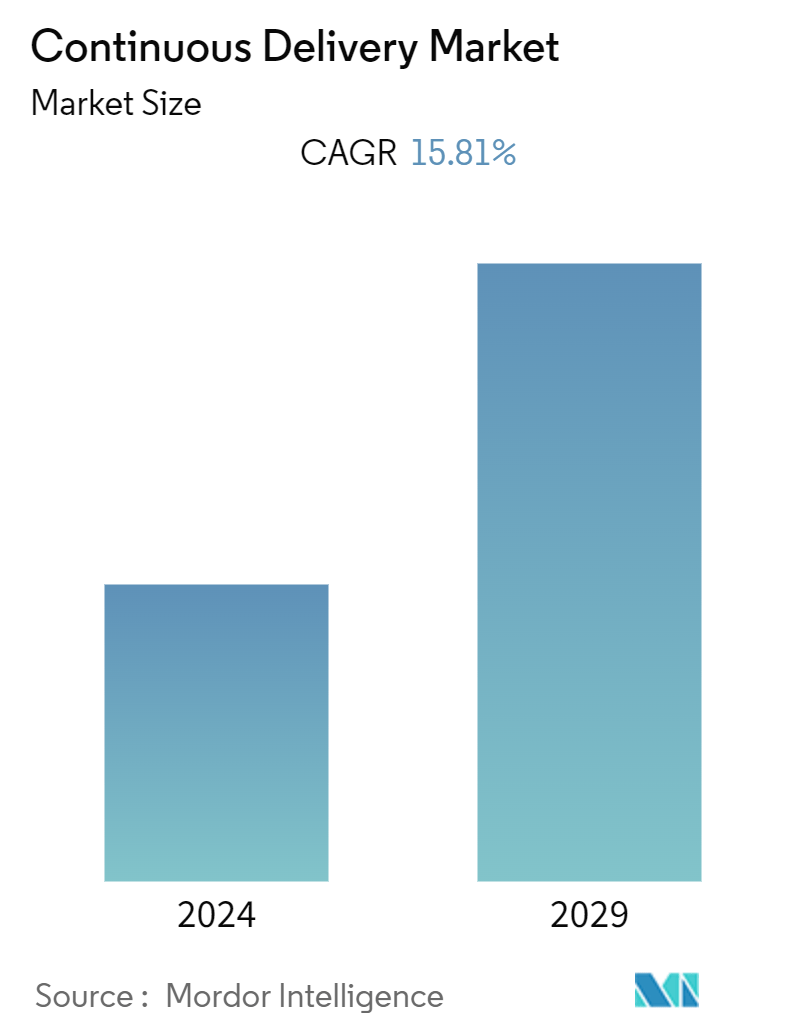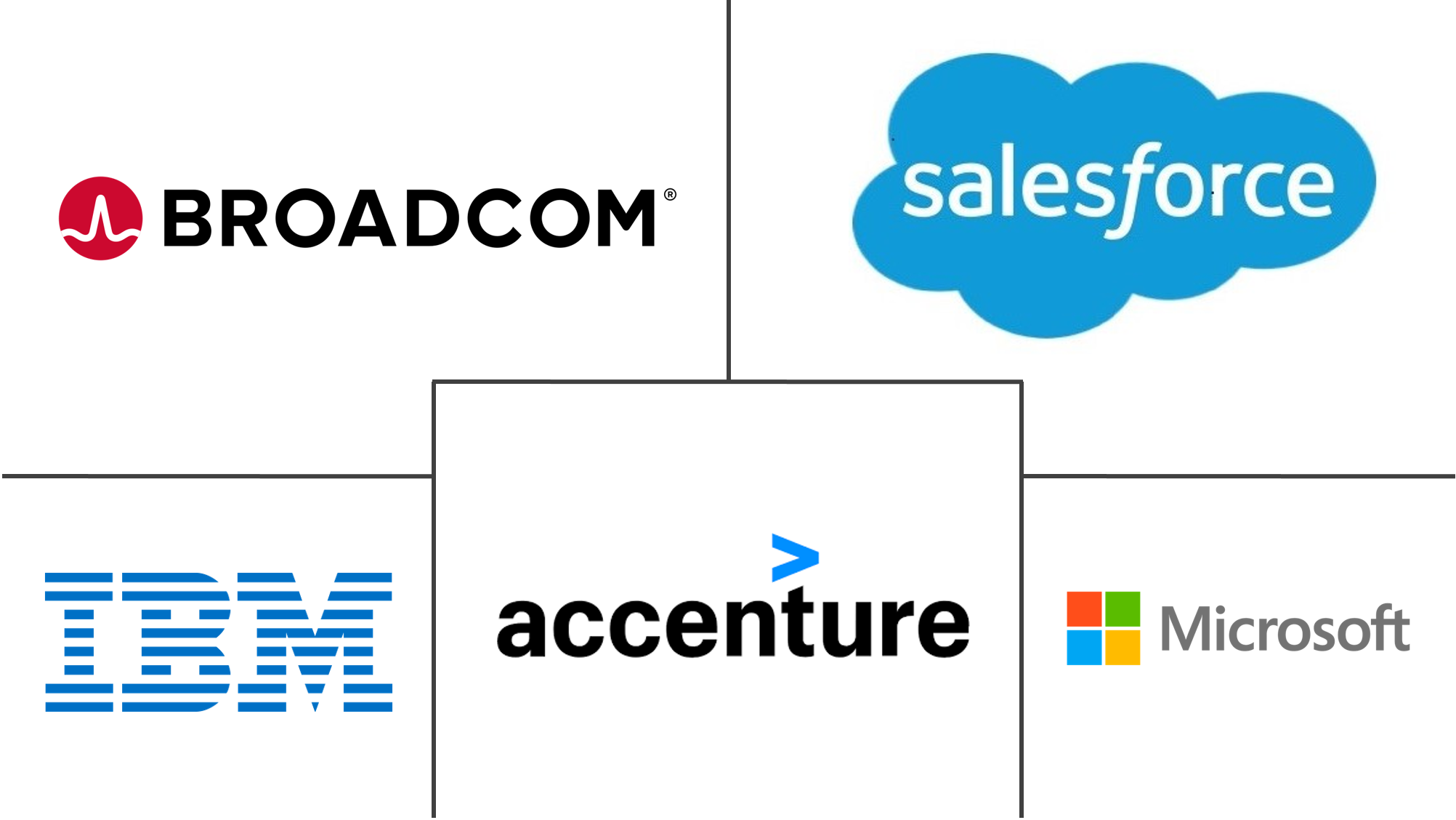Market Size of Continuous Delivery Industry

| Study Period | 2019 - 2029 |
| Base Year For Estimation | 2023 |
| CAGR (2024 - 2029) | 15.81 % |
| Fastest Growing Market | Asia-Pacific |
| Largest Market | North America |
| Market Concentration | Low |
Major Players
*Disclaimer: Major Players sorted in no particular order |
Continuous Delivery Market Analysis
The Continuous Delivery Market is expected to register a CAGR of 15.81% during the forecast period.
According to Perforce Software, Inc., an American software developer, 65% of managers, software developers, and executives report that their organizations have started using continuous delivery.
- The market for continuous delivery is expanding rapidly, owing primarily to the growth of artificial intelligence (AI) and machine learning (ML). AI/ML-powered technologies are transforming the software development process due to the rapid deployment of connected infrastructure and the rising autonomy of digital devices. These technologies enable self-regeneration systems, automate testing, forecast deployment results, improve release schedules, and provide smart monitoring and alarms.
- Moreover, Agile development approaches have grown in favor due to their ability to deliver software more quickly and flexibly. Continuous delivery aligns well with Agile principles, giving the software minor incremental updates rather than significant, periodic releases. According to Atlassian Corporation, an Australian software company, at least 71% of United States organizations use Agile. Further, Agile initiatives have a 64% success rate, while waterfall projects have a 49% success rate. Agile projects are 1.5X more successful than waterfall projects.
- The rising adoption of cloud computing and Infrastructure as Code has improved scaling and adaptability in infrastructure management. Continuous delivery swiftly allows enterprises to deploy and manage their applications in cloud configurations with cloud platforms and Infrastructure as Code tools. Continuous delivery CI/CD pipelines are automated processes enabling businesses and organizations to build, test, and deploy software quickly and reliably. Cloud infrastructure provides a flexible and scalable platform for running these processes, allowing companies to adapt to changing demands and optimize resource usage. These tools help organizations achieve greater business agility in several vital ways.
- However, open-source continuous delivery projects and tools are set to dominate the commercial straight delivery tools segment, driving the growth of the service steady delivery market. The constant delivery market helps businesses or enterprises change how they deliver services and run their businesses to be more accurate, save money, and be more productive. Also, it creates a lot of helpful information that helps people make better and faster decisions. This information can optimize current processes and operations or predict when, where, and how to offer the best products and services.
- However, the continuous market expansion may need to be improved due to businesses' reluctance to embrace change and integrate new technologies into their existing processes and toolchains. Many companies require support in adopting completely automated techniques for using DevOps and continuous delivery solutions.
Continuous Delivery Industry Segmentation
Continuous delivery refers to processes and methodologies that enable software teams to regularly and rapidly release high-quality code updates to production. It speeds up the software development process by automating build, testing, and deployment, minimizing the time between code changes and end-user deployment.
The Continuous Delivery Market is segmented by enterprise and small- and medium-sized enterprises), by end-user industry (BFSI, telecom & IT, retail and consumer goods, healthcare and life sciences, manufacturing, government and defense), and by geography (North America, Europe, Asia Pacific, Latin America, and the Middle East and Africa).
The market sizes and forecasts are provided in terms of value (in USD) for all the above segments.
| Deployment Type | |
| Cloud | |
| On-premise |
| Organization Size | |
| Large Enterprises | |
| Small and Medium-sized Enterprises |
| End User Industry | |
| BFSI | |
| Telecom and IT | |
| Retail and Consumer Goods | |
| Healthcare and Life Sciences | |
| Manufacturing | |
| Government and Defense | |
| Other End User Industries |
| Geography*** | |
| North America | |
| Europe | |
| Asia | |
| Latin America | |
| Middle East and Africa |
Continuous Delivery Market Size Summary
The continuous delivery market is experiencing rapid expansion, driven by advancements in artificial intelligence and machine learning, which are revolutionizing software development processes. These technologies facilitate the automation of testing, deployment forecasting, and smart monitoring, aligning seamlessly with Agile development methodologies that favor quick and flexible software delivery. The increasing adoption of cloud computing and Infrastructure as Code has further enhanced the scalability and adaptability of infrastructure management, allowing enterprises to deploy and manage applications efficiently in cloud environments. Continuous delivery tools, particularly those integrated with cloud platforms, offer businesses the agility to respond to changing demands and optimize resource utilization, thereby improving operational efficiency and decision-making.
Despite the promising growth trajectory, the market faces challenges due to organizational reluctance to adopt new technologies and fully automate processes. However, the rise of open-source continuous delivery projects is expected to dominate the commercial segment, driving market growth. The North American region is anticipated to lead in demand, fueled by early adoption of cloud-based technologies and IoT. The market is characterized by fragmentation, with numerous players introducing innovative solutions, making it highly competitive. Key industry players, including IBM, Microsoft, and Salesforce, are actively investing in cloud-based solutions and continuous delivery tools, further propelling market expansion. The integration of new technologies like predictive analytics with continuous delivery models is expected to enhance operational efficiency across various sectors, including retail, healthcare, and manufacturing.
Continuous Delivery Market Size - Table of Contents
-
1. MARKET DYNAMICS
-
1.1 Market Overview
-
1.2 Market Drivers
-
1.2.1 Increasing Demand For Automation Across Business Processes
-
1.2.2 Increasing Adoption Of Cloud Technology
-
-
1.3 Market Restraints
-
1.3.1 Maintaining Data Security And Privacy
-
-
1.4 Industry Value Chain Analysis
-
1.5 Industry Attractiveness - Porter's Five Forces Analysis
-
1.5.1 Bargaining Power of Suppliers
-
1.5.2 Bargaining Power of Buyers/Consumers
-
1.5.3 Threat of New Entrants
-
1.5.4 Threat of Substitute Products
-
1.5.5 Intensity of Competitive Rivalry
-
-
1.6 Assessment of COVID-19 impact on the industry
-
-
2. MARKET SEGMENTATION
-
2.1 Deployment Type
-
2.1.1 Cloud
-
2.1.2 On-premise
-
-
2.2 Organization Size
-
2.2.1 Large Enterprises
-
2.2.2 Small and Medium-sized Enterprises
-
-
2.3 End User Industry
-
2.3.1 BFSI
-
2.3.2 Telecom and IT
-
2.3.3 Retail and Consumer Goods
-
2.3.4 Healthcare and Life Sciences
-
2.3.5 Manufacturing
-
2.3.6 Government and Defense
-
2.3.7 Other End User Industries
-
-
2.4 Geography***
-
2.4.1 North America
-
2.4.2 Europe
-
2.4.3 Asia
-
2.4.4 Latin America
-
2.4.5 Middle East and Africa
-
-
Continuous Delivery Market Size FAQs
What is the current Continuous Delivery Market size?
The Continuous Delivery Market is projected to register a CAGR of 15.81% during the forecast period (2024-2029)
Who are the key players in Continuous Delivery Market?
Microsoft Corporation, IBM Corporation, Broadcom Inc. (CA Technologies), Salesforce.com and Accenture PLC are the major companies operating in the Continuous Delivery Market.

